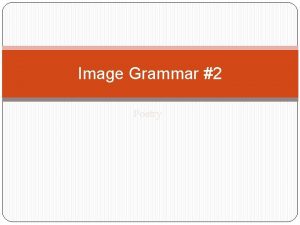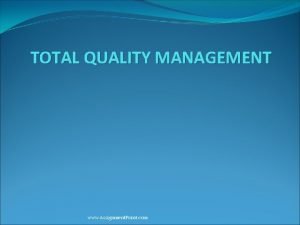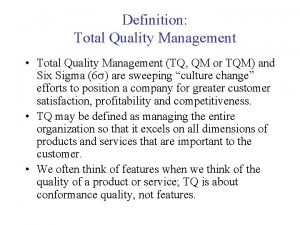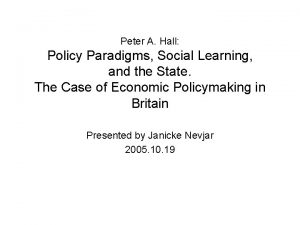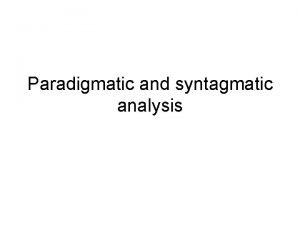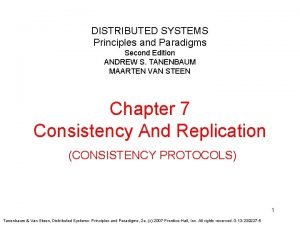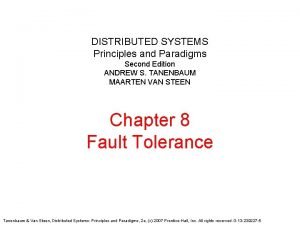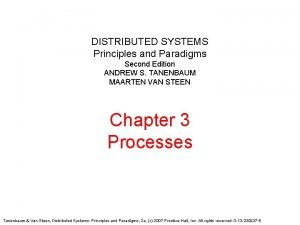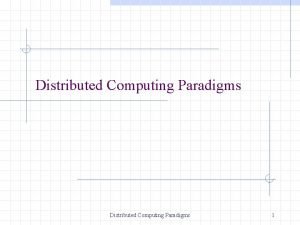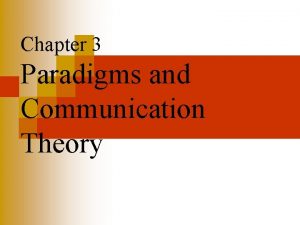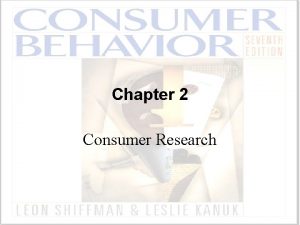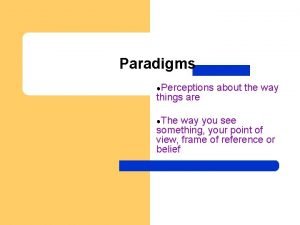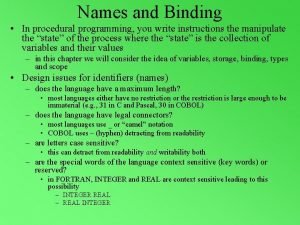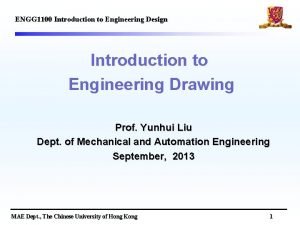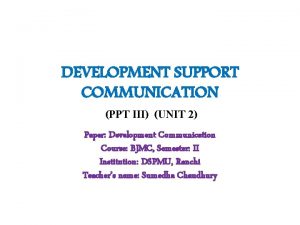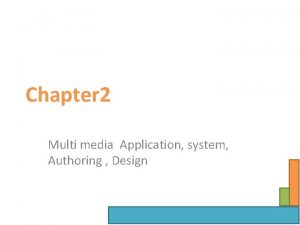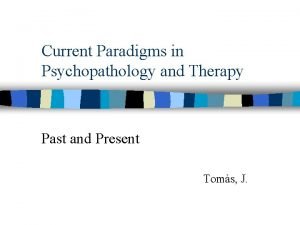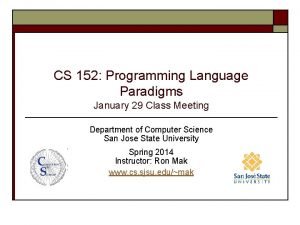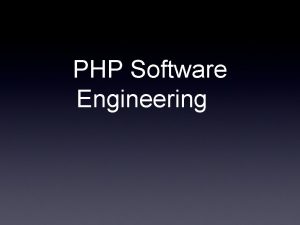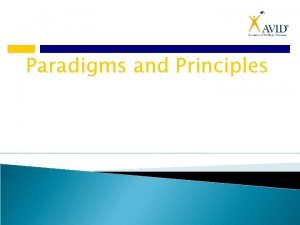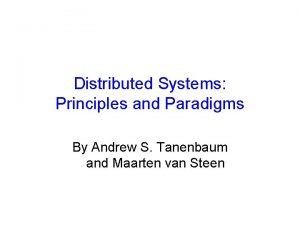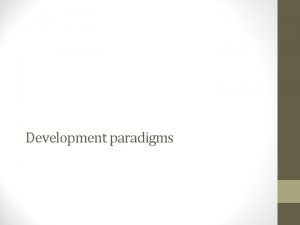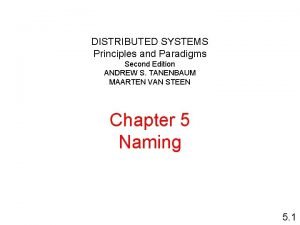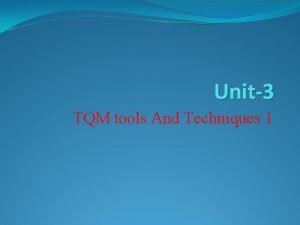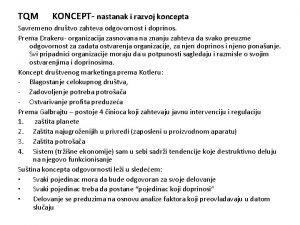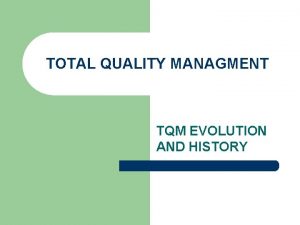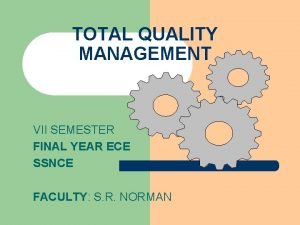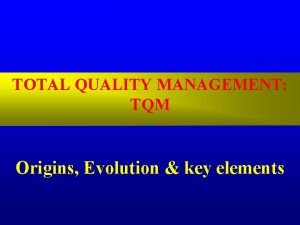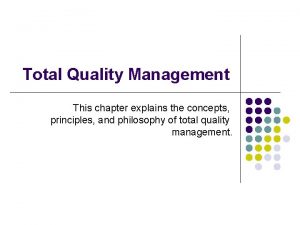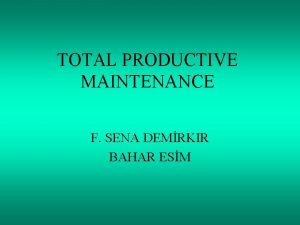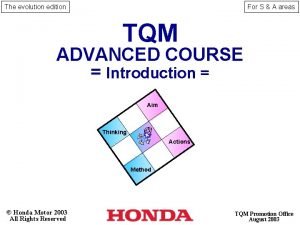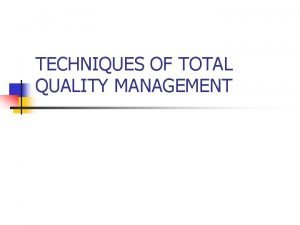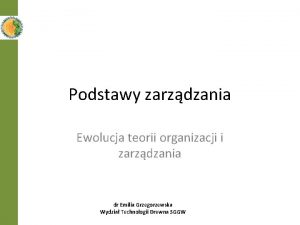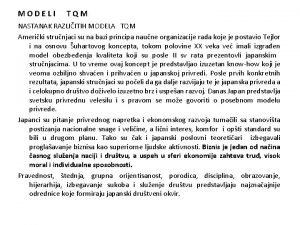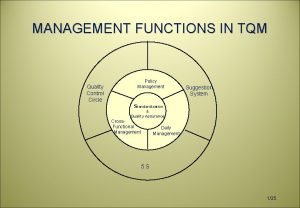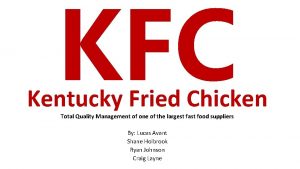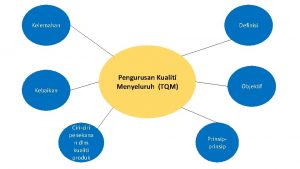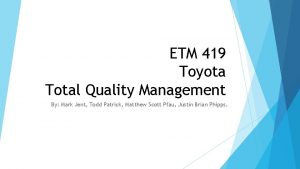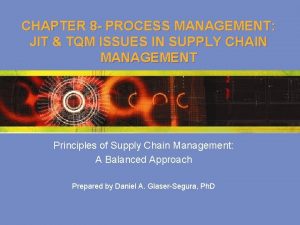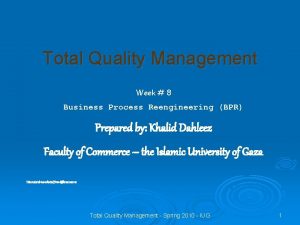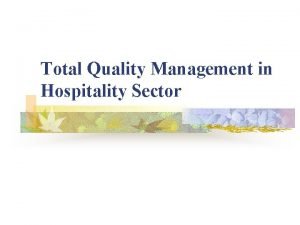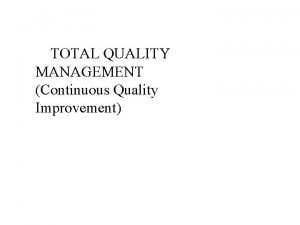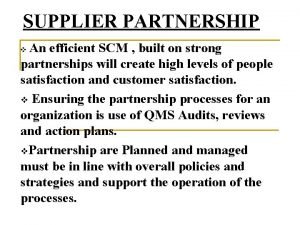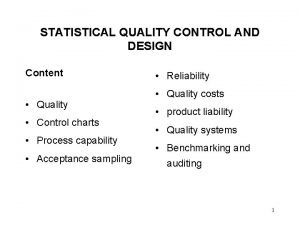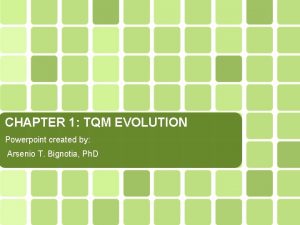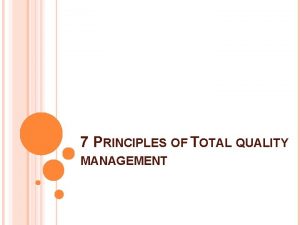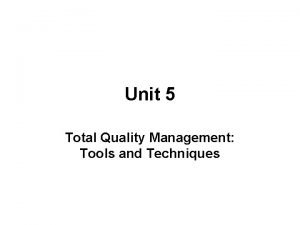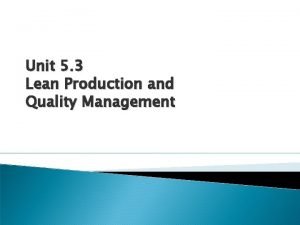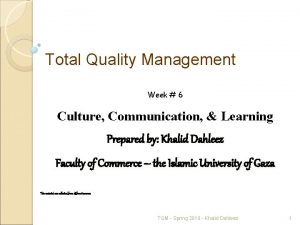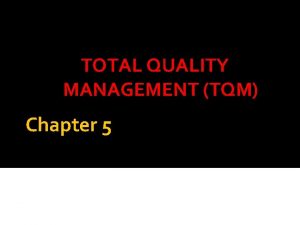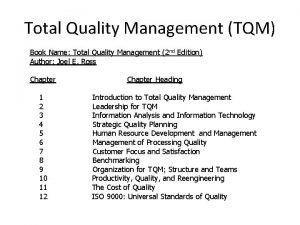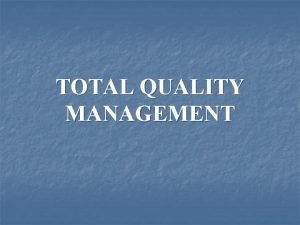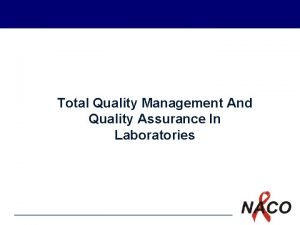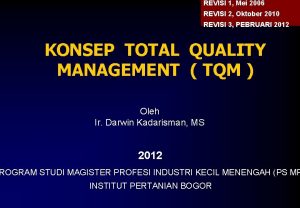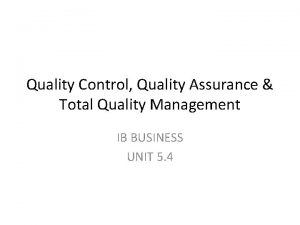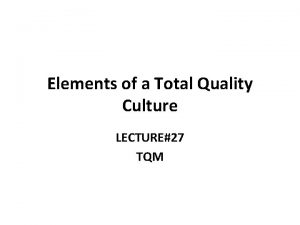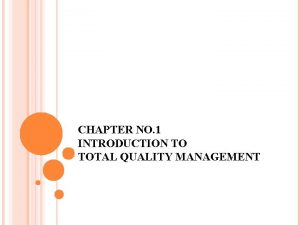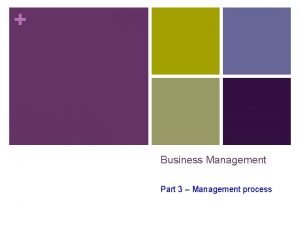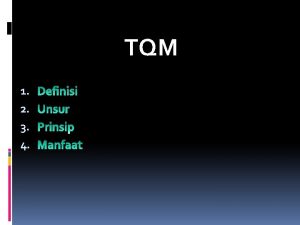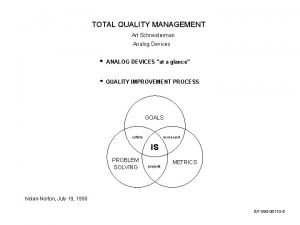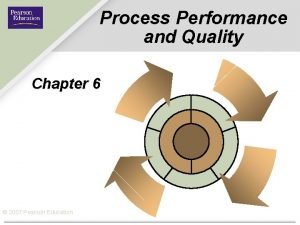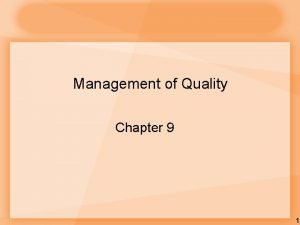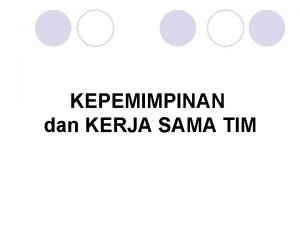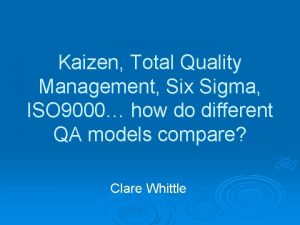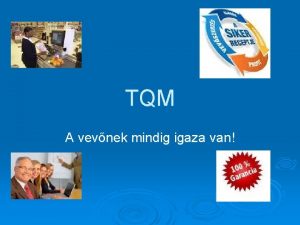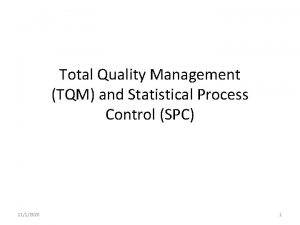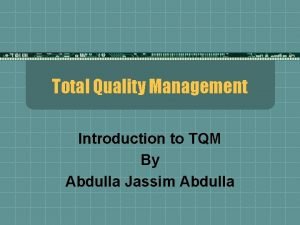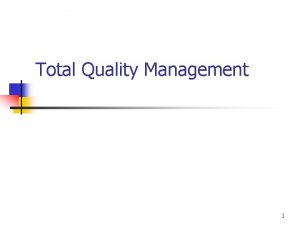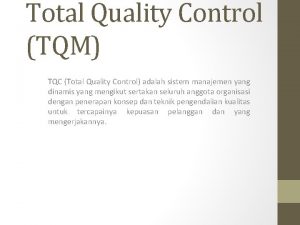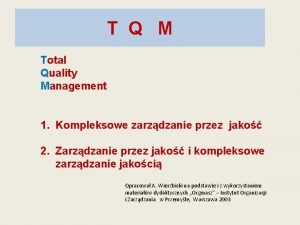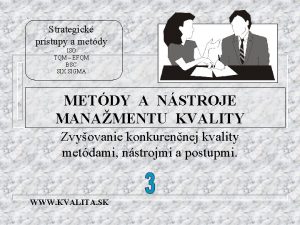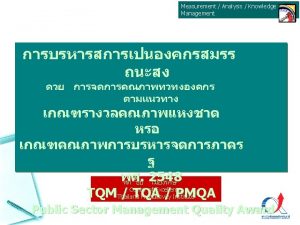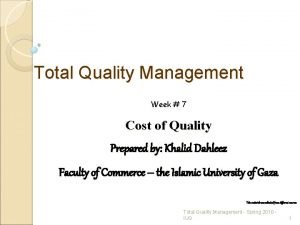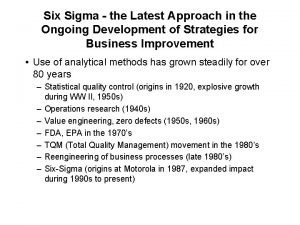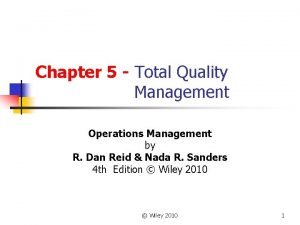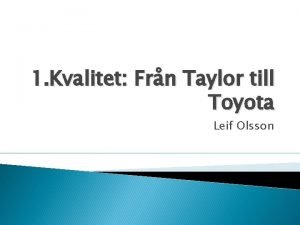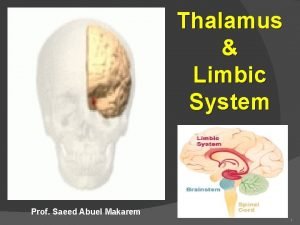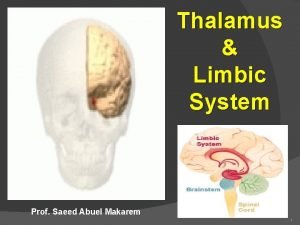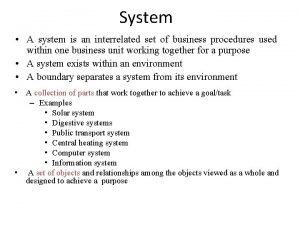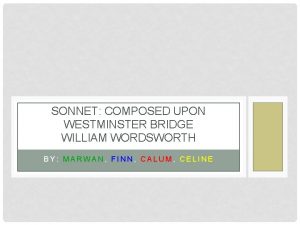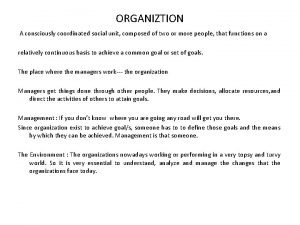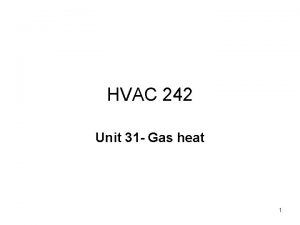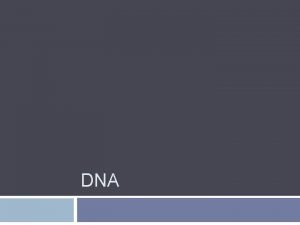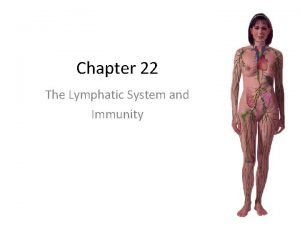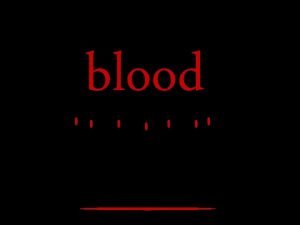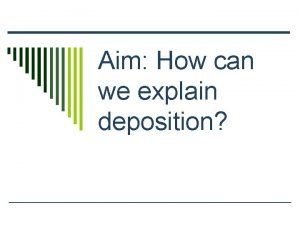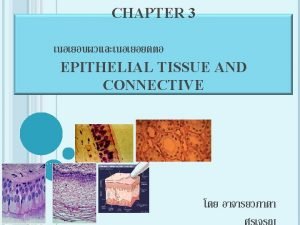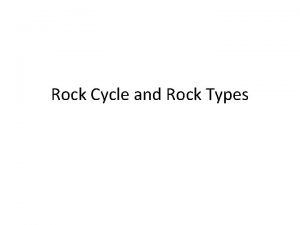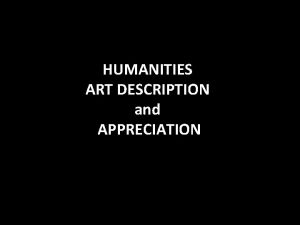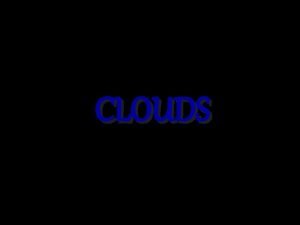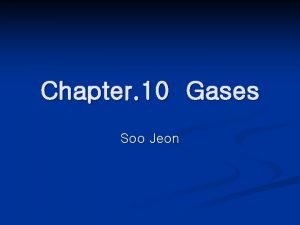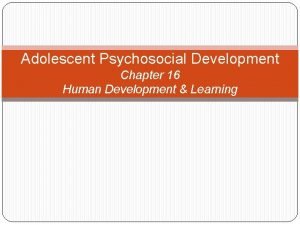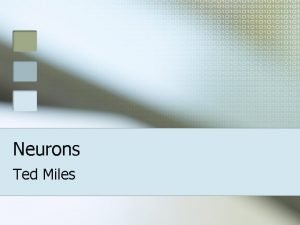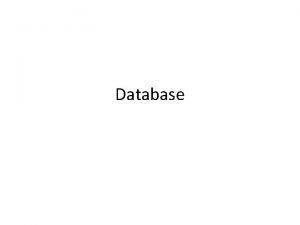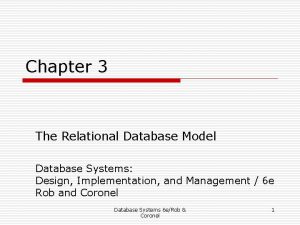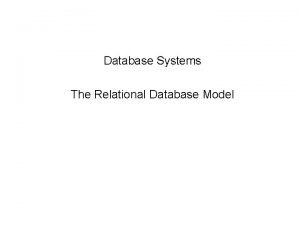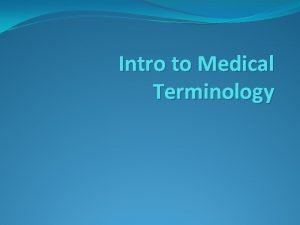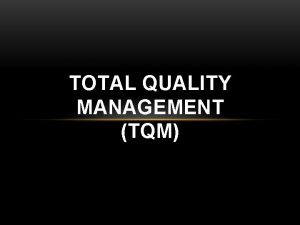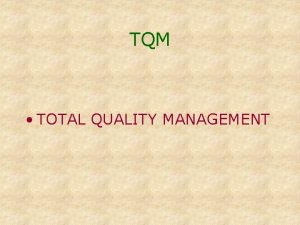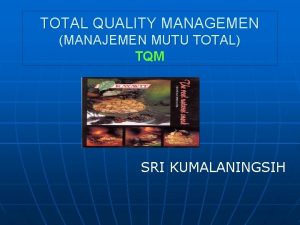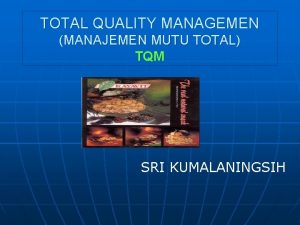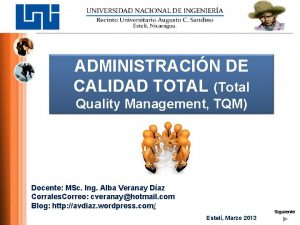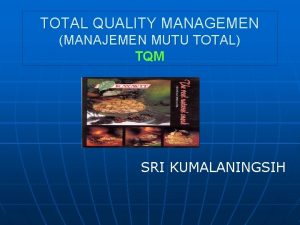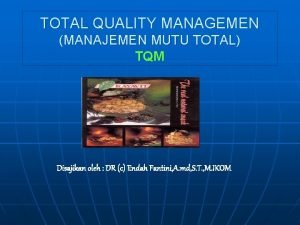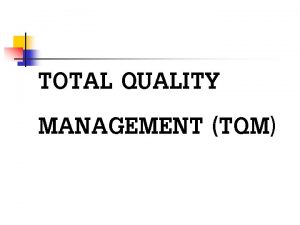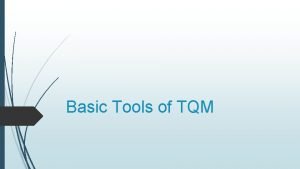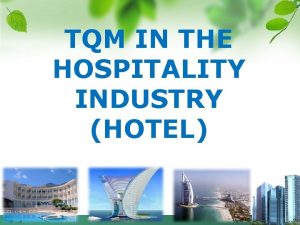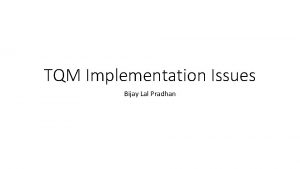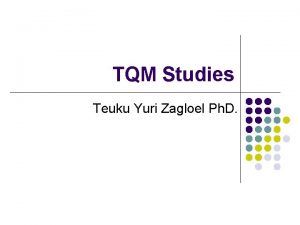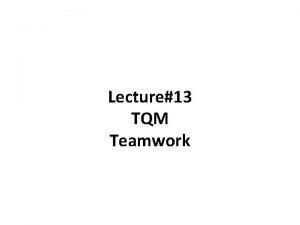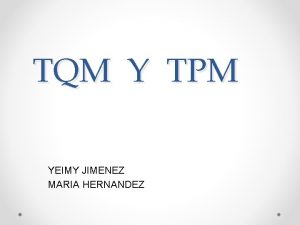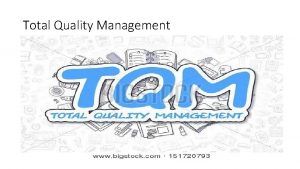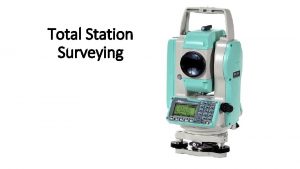Definition TQM is composed of three paradigms Total















































































































































- Slides: 143














Definition • TQM is composed of three paradigms: • Total: Involving the entire organization, supply chain, and/or product life cycle • Quality : With its usual definitions, with all its complexities • Management : The system of managing with steps like Plan, Organize, Control , Lead , Staff , provisioning and organizing.

• As defined by the International Organization for Standardization) ISO) – "TQM is a management approach for an organization, centered on quality, based on the participation of all its members and aiming at long -term success through customer satisfaction, and benefits to all members of the organization and to society. " ISO 8402: 1994

A Comprehensive Definition • Total Quality Management is the organization wide management of quality. • Management consists of planning, organizing, directing, control, and assurance. • Total quality is called total because it consists of two qualities : quality of return to satisfy the needs of the shareholders, and quality of products.

Quality management organizations and awards • The International Organization for Standardization's ISO 9000: 2000 series describes standards for a QMS addressing the principles and processes surrounding the design , development and delivery of a general product or service.

• Organisations can participate in a continuing certification process to ISO 9001: 2000 to demonstrate their compliance with the standard, which includes a requirement for continual (i. e. planned) improvement of the QMS)

• ISO 9000: 2000 provides guidance on Quality principles and on the common language used by quality professionals. • ISO 9004: 2000 provides guidance on improvement methods. • It can be seen that neither of these standards can be used for certification purposes as they provide guidance, not requirements. )

• The Malcolm Baldrige National Quality Award is a competition to identify and recognize top-quality U. S. companies. • This model addresses a broadly based range of quality criteria, including commercial success and corporate leadership. • Once an organization has won the award it has to wait several years before being eligible to apply again.

• The European Foundation for Quality Management's EFQM Excellence Model supports an award scheme similar to the Malcolm Baldrige Award for European companies.

• In Canada, the National Quality Institute presents the' Canada Awards for Excellence ' on an annual basis to organisations that have displayed outstanding performance in the areas of Quality and Workplace Wellness, and have met the Institute's criteria with documented overall achievements and results.

• The Alliance for Performance Excellence is a network of state, local, and international organizations that use the Malcolm Baldrige National Quality Award criteria and model at the grassroots level to improve the performance of local organizations and economies

• Network for Excellence. org is the Alliance web site; browsers can find Alliance members in their state and get the latest news and events from the Baldrige community.


























ISO

" ISO" International Organization for Standardization • International Organization for Standardization • " Organisation internationale de normalisation • • Formation 23 February 1947 Type NGO Purpose/focus International standard Headquarters Geneva , Switzerland Membership 157 members Official languages English and French Website www. iso. org

• The International Organization for Standardization )Organisation internationale de normalisation , ( widely known as ISO) • Pronounced ɑɪsəʊ • Is an international-standard-setting body composed of representatives from various national standards organizations. • Founded on 23 February , 1947 the organization promulgates world-wide proprietary industrial and commercial standards

• It is headquartered in Geneva , Switzerland • While ISO defines itself as a non-governmental organization , its ability to set standards that often become law, either through treaties or national standards, makes it more powerful than most non-governmental organizations. • In practice, ISO acts as a consortium with strong links to governments.


standards bodies who are ISO members • A map of • Key: • members • correspondent members • subscriber members • other places with an ISO 3166 -1 code, who aren't members of ISO

• ISO has 157 national members out of the 195 total countries in the world. • ISO has three membership categories: • Member bodies are national bodies that are considered to be the most representative standards body in each country. • These are the only members of ISO that have voting rights.

• Correspondent members are countries that do not have their own standards organization. • These members are informed about ISO's work, but do not participate in standards promulgation.

• Subscriber members are countries with small economies. • They pay reduced membership fees, but can follow the development of standards. • Participating members are called "P" members as opposed to observing members which are called "O" members.

ISO 9000 • ISO 9000 is a family of standards for quality management systems. • ISO 9000 is maintained by ISO, the International Organization for Standardization and is administered by accreditation and certification bodies. • Some of the requirements in ISO 9001 (which is one of the standards in the ISO 9000 family) include:

ISO 9001 requirements 1. A set of procedures that cover all key processes in the business ; 2. Monitoring processes to ensure they are effective ; 3. Keeping adequate records ; 4. Checking output for defects, with appropriate and corrective action where necessary ; 5. Regularly reviewing individual processes and the quality system itself for effectiveness; and 6. Facilitating continual improvement

Understandings: • A company or organization that has been independently audited and certified to be in conformance with ISO 9001 may publicly state that it is "ISO 9001 certified" or "ISO 9001 registered. " • Certification to an ISO 9000 standard does not guarantee the compliance (and therefore the quality) of end products and services; rather, it certifies that consistent business processes are being applied. • Indeed, some companies enter the ISO 9001 certification as a marketing tool.

• Although the standards originated in manufacturing , they are now employed across a wide range of other types of organizations. • A "product", in ISO vocabulary, can mean a physical object, or services, or software. • In fact, according to ISO in 2004" , service sectors now account by far for the highest number of ISO 9001: 2000 certificates - about 31% of the total".

The standard specifies six compulsory documents: 1. Control of Documents (4. 2. 3) 2. Control of Records (4. 2. 4) 3. Internal Audits (8. 2. 2) 4. Control of Nonconforming Product / Service (8. 3) 5. Corrective Action (8. 5. 2) 6. Preventive Action (8. 5. 3) In addition to these, ISO 9001: 2000 requires a Quality Policy and Quality Manual (which may or may not include the above documents. )

Summary of ISO 9001: 2000 in informal language • The quality policy is a formal statement from management, closely linked to the business and marketing plan and to customer needs. • The quality policy is understood and followed at all levels and by all employees. • Each employee needs measurable objectives to work towards.

• Decisions about the quality system are made based on recorded data and the system is regularly audited and evaluated for conformance and effectiveness. • Records should show and where raw materials and products were processed, to allow products and problems to be traced to the source.

• You need a documented procedure to control quality documents in your company. • Everyone must have access to up-to-date documents and be aware of how to use them. • To maintain the quality system and produce conforming product, you need to provide suitable infrastructure, resources, information, equipment, measuring and monitoring devices, and environmental conditions.

• You need to map out all key processes in your company; control them by monitoring, measurement and analysis; and ensure that product quality objectives are met. • If you can’t monitor a process by measurement, then make sure the process is well enough defined that you can make adjustments if the product does not meet user needs

• For each product your company makes, you need to establish quality objectives; plan processes; and document and measure results to use as a tool for improvement. • For each process, determine what kind of procedural documentation is required (note: a “product” is hardware, software, services, processed materials, or a combination of these. )

• You need to determine key points where each process requires monitoring and measurement, and ensure that all monitoring and measuring devices are properly maintained and calibrated

• You need to have clear requirements for purchased product. • You need to determine customer requirements and create systems for communicating with customers about product information, inquiries, contracts, orders, feedback and complaints.

• When developing new products, you need to plan the stages of development, with appropriate testing at each stage. • You need to test and document whether the product meets design requirements, regulatory requirements and user needs.

• You need to regularly review performance through internal audits and meetings. • Determine whether the quality system is working and what improvements can be made. • Deal with past problems and potential problems. • Keep records of these activities and the resulting decisions, and monitor their effectiveness (note: you need a documented procedure for internal audits. )

• You need documented procedures for dealing with actual and potential non-conformances (problems involving suppliers or customers, or internal problems). • Make sure no one uses bad product, determine what to do with bad product, deal with the root cause of the problem and keep records to use as a tool to improve the system

2000 version • ISO 9001: 2000 combines the three standards 9001, 9002, and 9003 into one, called 9001. • Design and development procedures are required only if a company does in fact engage in the creation of new products. • The 2000 version sought to make a radical change in thinking by actually placing the concept of process management front and center ("Process management" was the monitoring and optimizing of a company's tasks and activities, instead of just inspecting the final product).

• The 2000 version also demands involvement by upper executives, in order to integrate quality into the business system and avoid delegation of quality functions to junior administrators. • Another goal is to improve effectiveness via process performance metrics — numerical measurement of the effectiveness of tasks and activities. • Expectations of continual process improvement and tracking customer satisfaction were made explicit

Future version: 2008 • TC 176, the ISO 9001 technical committee, has started its review on the next version of ISO 9001, which will in all likelihood be termed the ISO 9001: 2008 standard, assuming its planned release date of 2008 is met. • Early reports are that the standard will not be substantially changed from its 2000 version.

• As with the release of previous versions, organizations registered to ISO 9001 will be given a substantial period to transition to the new version of the standard, assuming changes are needed; organizations registered to 9001: 1994 had until December of 2003 to undergo upgrade audits. • The forthcoming ISO 9001: 2008 international standard is likely to be published by October November 2008.

Certification • ISO does not itself certify organizations. • Many countries have formed accreditation bodies to authorize certification bodies, which audit organizations applying for ISO 9001 compliance certification. • Although commonly referred to as ISO 9000: 2000 certification, the actual standard to which an organization's quality management can be certified is ISO 9001: 2000.

• Both the accreditation bodies and the certification bodies charge fees for their services. • The various accreditation bodies have mutual agreements with each other to ensure that certificates issued by one of the Accredited Certification Bodies) CB) are accepted worldwide.

• The applying organization is assessed based on an extensive sample of its sites, functions, products, services and processes; a list of problems ("action requests" or "non-compliances") is made known to the management. • If there are no major problems on this list, the certification body will issue an ISO 9001 certificate for each geographical site it has visited, once it receives a satisfactory improvement plan from the management showing how any problems will be resolved.

• An ISO certificate is not a once-and-for-all award, but must be renewed at regular intervals recommended by the certification body, usually around three years. • In contrast to the Capability Maturity Model there are no grades of competence within ISO 9001.

Auditing • Two types of auditing are required to become registered to the standard: auditing by an external certification body )external audit (and audits by internal staff trained for this process) internal audits( • The aim is a continual process of review and assessment, to verify that the system is working as it's supposed to, find out where it can improve and to correct or prevent problems identified. • It is considered healthier for internal auditors to audit outside their usual management line, so as to bring a degree of independence to their judgments. • Under the 1994 standard, the auditing process could be adequately addressed by performing "compliance auditing

• Tell me what you do) describe the business process( • Show me where it says that) reference the procedure manuals( • Prove that is what happened) exhibit evidence in documented records( • How this led to preventive actions was not clear. • The 2000 standard uses the process approach. • While auditors perform similar functions, they are expected to go beyond mere auditing for rote "compliance" by focusing on risk, status and importance.

• This means they are expected to make more judgments on what is effective, rather than merely adhering to what is formally prescribed. • The difference from the previous standard can be explained thus: – Under the 1994 version, the question was broadly "Are you doing what the manual says you should be doing? ", whereas under the 2000 version, the question is more "Will this process help you achieve your stated objectives? Is it a good process or is there a way to do it better. "? • The ISO 19011 standard for auditing applies to ISO 9001 besides other management systems like EMS ( ISO 14001), FSMS (ISO 22000) etc.

Debate on the effectiveness of ISO 9000 • The debate on the effectiveness of ISO 9000 commonly centers on the following questions: • Are the quality principles in ISO 9000: 2000 of value (note that the version date is important: in the 2000 version ISO attempted to address many concerns and criticisms of ISO 9000: 1994 ? ( • Does it help to implement an ISO 9001: 2000 compliant quality management system ? • Does it help to obtain ISO 9001: 2000 certification ?

Advantages • It is widely acknowledged that proper quality management improves business, often having a positive effect on investment, market share, sales growth, sales margins, competitive advantage, and avoidance of litigation • The quality principles in ISO 9000: 2000 are also sound, according to Wade, and Barnes , who says "ISO 9000 guidelines provide a comprehensive model for quality management systems that can make any competitive. "

• Barnes also cites a survey by Lloyd's Register Quality Assurance which indicated that ISO 9000 increased net profit, and another by Deloitte-Touche which reported that the costs of registration were recovered in three years. • According to the Providence Business News, implementing ISO often gives the following advantages:

1. 2. 3. 4. 5. Create a more efficient, effective operation Increase customer satisfaction and retention Reduce audits Enhance marketing Improve employee motivation, awareness, and morale 6. Promote international trade 7. Increases profit 8. Reduce waste and increases productivity

• However, a broad statistical study of 800 Spanish companies, found that ISO 9000 registration in itself creates little improvement because companies interested in it have usually already made some type of commitment to quality management and were performing just as well before registration.

• In today's service-sector driven economy, more and more companies are using ISO 9000 as a business tool. • Through the use of properly stated quality objectives, customer satisfaction surveys and a well-defined continual improvement program companies are using ISO 9000 processes to increase their efficiency and profitability.

Problems • A common criticism of ISO 9001 is the amount of money, time and paperwork required for registration • According to Barnes, "Opponents claim that it is only for documentation. • Proponents believe that if a company has documented its quality systems, then most of the paperwork has already been completed

• According to Seddon, ISO 9001 promotes specification, control, and procedures rather than understanding and improvement • Wade argues that ISO 9000 is effective as a guideline, but that promoting it as a standard "helps to mislead companies into thinking that certification means better quality, . . . [undermining] the need for an organization to set its own quality standards". • Paraphrased, Wade's argument is that total, blind reliance on the specifications of ISO 9001 does not guarantee a successful quality system.

• The standard is seen as especially prone to failure when a company is interested in certification before quality • Certifications are in fact often based on customer contractual requirements rather than a desire to actually improve quality“ • If you just want the certificate on the wall, chances are, you will create a paper system that doesn't have much to do with the way you actually run your business, " said ISO's Roger Frost

• Certification by an independent auditor is often seen as the problem area, and according to Barnes, "has become a vehicle to increase consulting services • In fact, ISO itself advises that ISO 9001 can be implemented without certification, simply for the quality benefits that can be achieved.

• Another problem reported is the competition among the numerous certifying bodies, leading to a softer approach to the defects noticed in the operation of the Quality System of a firm.

ISO 14000 • The ISO 14000 environmental management standards exist to help organizations minimize how their operations negatively affect the environment (cause adverse changes to air, water, or land) and comply with applicable laws and regulations.

• ISO 14001 is the international specification for an environmental management system) EMS). • It specifies requirements for establishing an environmental policy, determining environmental aspects and impacts of products/activities/services, planning environmental objectives and measurable targets, implementation and operation of programs to meet objectives and targets, checking and corrective action, and management review.

• ISO 14000 is similar to ISO 9000 quality management in that both pertain to the process (the comprehensive outcome of how a product is produced) rather than to the product itself. • The overall idea is to establish an organized approach to systematically reduce the impact of the environmental aspects which an organization can control. • Effective tools for the analysis of environmental aspects of an organization and for the generation of options for improvement are provided by the concept of Cleaner Production.

• As with ISO 9000, certification is performed by third-party organizations rather than being awarded by ISO directly. • The ISO 19011 audit standard applies when auditing for both 9000 and 14000 compliance at once.

Standards • The material included in this family of specifications is very broad. • The major parts of ISO 14000 are: • ISO 14001 is the standard against which organizations are assessed. • ISO 14001 is generic and flexible enough to apply to any organization producing and/or manufacturing any product, or even providing a service anywhere in the world

• ISO 14004 is a guidance document that explains the 14001 requirements in more detail. • These present a structured approach to setting environmental objectives and targets and to establishing and monitoring operational controls.

• These are further expanded upon by the following: • ISO 14020 series (14020 to 14025), Environmental Labeling, covers labels and declarations. • ISO 14030 discusses post-production environmental assessment. • ISO 14031 Evaluation of Environmental Performance. • ISO 14040 series (14040 to 14044 , (Life Cycle Assessment, LCA , discusses pre-production planning and environment goal setting.

• ISO 14050 terms and definitions. • ISO 14062 discusses making improvements to environmental impact goals. • ISO 14063 is an addendum to 14020, discussing further communications on environmental impact.

• Is Greenhouse gases – Part 1: Specification with guidance at the organization level for the description, quantification and reporting of greenhouse gas emissions and removals. • Is Greenhouse gases – Part 2: Specification with guidance at the project level for the description, quantification, monitoring and reporting of greenhouse gas emission reductions and removal enhancements.

• Is Greenhouse gases – Part 3: Specification with guidance for the validation and verification of greenhouse gas assertion.

• ISO 19011 which specifies one audit protocol for both 14000 and 9000 series standards together. • This replaces ISO 14011 meta-evaluation— how to tell if your intended regulatory tools worked. • 19011 is now the only recommended way to determine this.

Environmental management system • The Environmental Management System )EMS) is part of a management system of an organization) enterprise, authority, etc. ), in which specific competencies, behaviours, procedures and demands for the implementation of an operational environmental policy of the organization are defined.

Legislation and standards • Within the European Union (EU) legislation was introduced to encourage businesses to voluntarily adopt ISO 14000. • Regulation (EC) No 761/2001 of the European Parliament and of the Council of 19 March 2001, allowed voluntary participation by organisations in a Community ecomanagement and audit scheme Eco-Management and Audit Scheme) EMAS. ( • The implementation of a robust EMS, which may incorporate ISO 14001, should lead to improved environmental performance, including better and more consistent legal compliance.

• The ISO 14000 standards reflect different aspects of environmental management. The following list outlines the broad coverage of each: • Environmental Management Systems : – 14004 , 14002 , 14001 • Environmental Auditing : – 19011 • Environmental Labeling : – 14025 , 14024 , 14023 , 14022 , 14021 , 14020 • Life Cycle Assessment : – 14043 , 14042 , 14041 , 14040

Benefits • There a range of benefits associated with operating an effective Environmental Management Systems (EMS)

Financial • Cost savings through the reduction of waste and more efficient use of natural resources (electricity, water, gas and fuels (. • Avoiding fines and penalties from not meeting environmental legislation by identifying environmental risks and addressing weaknesses. • Reduction in insurance costs by demonstrating better risk management

Operational and Internal • Improved overall performance and efficiency. • Able to monitor and reflect (audit) your businesses and see which areas need intervention

External • Better public perception of the organization, leading to improved sales • Reduction of the impact (e. g. noises, smells, dust) of your activities on the local residents, leading to more community support

ISO 9000

• The previous members of the ISO 9000 family, 9001, 9002 and 9003, have all been integrated into 9001. • In most cases, an organization claiming to be "ISO 9000 registered" is referring to ISO 9001.

• Records should show and where raw materials and products were processed, to allow products and problems to be traced to the source. • You need a documented procedure to control quality documents in your company. • Everyone must have access to up-to-date documents and be aware of how to use them.

• To maintain the quality system and produce conforming product, you need to provide suitable infrastructure, resources, information, equipment, measuring and monitoring devices, and environmental conditions. • You need to map out all key processes in your company; control them by monitoring, measurement and analysis; and ensure that product quality objectives are met.

• If you can’t monitor a process by measurement, then make sure the process is well enough defined that you can make adjustments if the product does not meet user needs.

• 1. 2. 3. 4. • • For each product your company makes, you need to: Establish quality objectives; Plan processes; and Document and Measure results to use as a tool for improvement. For each process, determine what kind of procedural documentation is required. (Note: a “product” is hardware, software, services, processed materials, or a combination of these).

• You need to determine key points where each process requires monitoring and measurement, and ensure that all monitoring and measuring devices are properly maintained and calibrated. • You need to have clear requirements for purchased product.

• You need to determine customer requirements and create systems for communicating with customers about product information, inquiries, contracts, orders, feedback and complaints. • When developing new products, you need to plan the stages of development, with appropriate testing at each stage. • You need to test and document whether the product meets design requirements, regulatory requirements and user needs.

• You need to regularly review performance through internal audits and meetings. • Determine whether the quality system is working and what improvements can be made. • Deal with past problems and potential problems. Keep records of these activities and the resulting decisions, and monitor their effectiveness. • (Note: you need a documented procedure for internal audits).

• You need documented procedures for dealing with actual and potential non-conformances (problems involving suppliers or customers, or internal problems). • Make sure no one uses bad product, determine what to do with bad product, deal with the root cause of the problem and keep records to use as a tool to improve the system










ﺍﻟﺘﺤﻠﻴﻞ ﺍﻟﺮﺑﺎﻋﻲ S W O T Analysis Threats Strength Weakness Opportunities










 Blues poem example
Blues poem example Meaning of total quality management
Meaning of total quality management Definition of tqm
Definition of tqm Peter hall policy paradigms
Peter hall policy paradigms Balaji psychology
Balaji psychology 7 habits paradigms
7 habits paradigms Paradigmatic vs syntagmatic
Paradigmatic vs syntagmatic Example of paradigm in hci
Example of paradigm in hci Distributed systems: principles and paradigms
Distributed systems: principles and paradigms Message ordering paradigms
Message ordering paradigms Distributed systems principles and paradigms
Distributed systems principles and paradigms Distributed computation paradigms
Distributed computation paradigms 3 paradigms
3 paradigms Interpretivist approach to consumer behavior
Interpretivist approach to consumer behavior Boyfriend/girlfriend centered paradigm
Boyfriend/girlfriend centered paradigm Binding in programming paradigms
Binding in programming paradigms Ktu programming paradigms notes
Ktu programming paradigms notes Alternative paradigm of development ppt
Alternative paradigm of development ppt Multimedia application design
Multimedia application design Evaluation paradigms
Evaluation paradigms Biological paradigm of psychopathology
Biological paradigm of psychopathology R programming language paradigms
R programming language paradigms Php paradigms
Php paradigms Paradigms and principles
Paradigms and principles Distributed systems principles and paradigms
Distributed systems principles and paradigms Paradigms of development
Paradigms of development Distributed systems principles and paradigms
Distributed systems principles and paradigms Unidad 3 razones financieras
Unidad 3 razones financieras Total revenues minus total costs equals
Total revenues minus total costs equals Total revenues minus total costs equals
Total revenues minus total costs equals Total revenues minus total costs equals
Total revenues minus total costs equals Total revenue minus total expenses
Total revenue minus total expenses The total area of the surface of a three dimensional object
The total area of the surface of a three dimensional object Three girls downloaded a total of 36 songs
Three girls downloaded a total of 36 songs Tqm tools and techniques
Tqm tools and techniques Tqm koncept
Tqm koncept Tqm modell
Tqm modell History of tqm
History of tqm Four improvement strategies in tqm
Four improvement strategies in tqm Total quality management 14 points
Total quality management 14 points Fundamental principles of tqm
Fundamental principles of tqm Tqm six basic concepts
Tqm six basic concepts Benefits of tqm
Benefits of tqm Tpm means
Tpm means Honda three reality principle
Honda three reality principle Techniques of tqm
Techniques of tqm Which of the gurus would be the father of quality control?
Which of the gurus would be the father of quality control? Piramida tqm
Piramida tqm Model tqm
Model tqm Function of tqm
Function of tqm Kfc tqm
Kfc tqm Objektif merekayasa
Objektif merekayasa Weakness of toyota
Weakness of toyota Communication in tqm
Communication in tqm Jit & tqm issues in supply chain management
Jit & tqm issues in supply chain management Bpr in tqm
Bpr in tqm Quality policy statement
Quality policy statement Quality journey
Quality journey Tqm in hospitality industry
Tqm in hospitality industry Cqi tqm
Cqi tqm Tqm supplier partnership
Tqm supplier partnership Statistical quality control
Statistical quality control Evolution of tqm ppt
Evolution of tqm ppt Tqm fishbone diagram
Tqm fishbone diagram Objetivos del tqm
Objetivos del tqm 7 principles of total quality management
7 principles of total quality management Quality management tools and techniques
Quality management tools and techniques Disadvantages of quality management
Disadvantages of quality management Old quality vs new quality
Old quality vs new quality Communication in tqm
Communication in tqm Purpose of tqm
Purpose of tqm Books on total quality management
Books on total quality management Introduction to total quality management
Introduction to total quality management How to achieve tqm
How to achieve tqm Poka yoke in tqm
Poka yoke in tqm Ishikawa tqm
Ishikawa tqm Disadvantages of tqm
Disadvantages of tqm Quality culture in tqm
Quality culture in tqm What is tqm
What is tqm Operations management with total quality management book
Operations management with total quality management book How to achieve tqm
How to achieve tqm Definisi tqm
Definisi tqm Arthur schneiderman
Arthur schneiderman Tqm wheel
Tqm wheel Tqm failure
Tqm failure Manajemen konflik yang sesuai dengan tqm
Manajemen konflik yang sesuai dengan tqm Six sigma iso 9000
Six sigma iso 9000 Tqm folyamatjavítási módszerei
Tqm folyamatjavítási módszerei Pengertian total quality management
Pengertian total quality management Tqm triangle
Tqm triangle Philosophies of total quality management
Philosophies of total quality management Total quality control tqc
Total quality control tqc Tqm definicja
Tqm definicja Tqm efqm
Tqm efqm Measurement analysis and knowledge management
Measurement analysis and knowledge management Scatter diagram in tqm
Scatter diagram in tqm Cost of quality examples
Cost of quality examples Tqm failure
Tqm failure Reliability in series and parallel tqm
Reliability in series and parallel tqm Toyota tqm
Toyota tqm Enzymes are composed of what organic molecule
Enzymes are composed of what organic molecule Wordsworth the solitary reaper
Wordsworth the solitary reaper Modified chen notation
Modified chen notation Leminsci
Leminsci Vplnt
Vplnt Interrelated components meaning
Interrelated components meaning Skin composed of
Skin composed of William wordsworth sonnet 14
William wordsworth sonnet 14 Consciously coordinated meaning
Consciously coordinated meaning Money madness poem
Money madness poem Tintern abbey summary
Tintern abbey summary Unit 31 gas heat
Unit 31 gas heat Dideoxyribonucleic
Dideoxyribonucleic Lymphatic system is composed of
Lymphatic system is composed of What is blood composed of
What is blood composed of What is blood composed of
What is blood composed of Jj johnson
Jj johnson A low hill is composed of unsorted sediments
A low hill is composed of unsorted sediments Areolar connective tissue description
Areolar connective tissue description Triglycerides are composed of
Triglycerides are composed of Wood is composed of
Wood is composed of Self portrait composed of many pieces
Self portrait composed of many pieces Is a self-portrait composed of many pieces
Is a self-portrait composed of many pieces Composed mainly of minerals with blocky crystal shapes
Composed mainly of minerals with blocky crystal shapes The nucleolus is composed chiefly of:
The nucleolus is composed chiefly of: What is a light
What is a light Humanities art appreciation
Humanities art appreciation Mealy asm chart
Mealy asm chart Huygens principle features wavefronts that are composed of
Huygens principle features wavefronts that are composed of Earth has not anything to show more fair figure of speech
Earth has not anything to show more fair figure of speech How high up do clouds form
How high up do clouds form An unknown gas composed of homonuclear diatomic molecules
An unknown gas composed of homonuclear diatomic molecules It is a self-portrait composed of many pieces.
It is a self-portrait composed of many pieces. Movable plate that covers the opening of lower threading.
Movable plate that covers the opening of lower threading. What are neurons composed of
What are neurons composed of Traditionally, composed of a collection of file folders.
Traditionally, composed of a collection of file folders. Two-dimensional structure composed of rows and columns
Two-dimensional structure composed of rows and columns Two-dimensional structure composed of rows and columns
Two-dimensional structure composed of rows and columns The ffa emblem is composed of
The ffa emblem is composed of Whats in an essay
Whats in an essay What is the olympic creed
What is the olympic creed Universe is composed of
Universe is composed of Carl linnaeus
Carl linnaeus Medical word parts
Medical word parts
